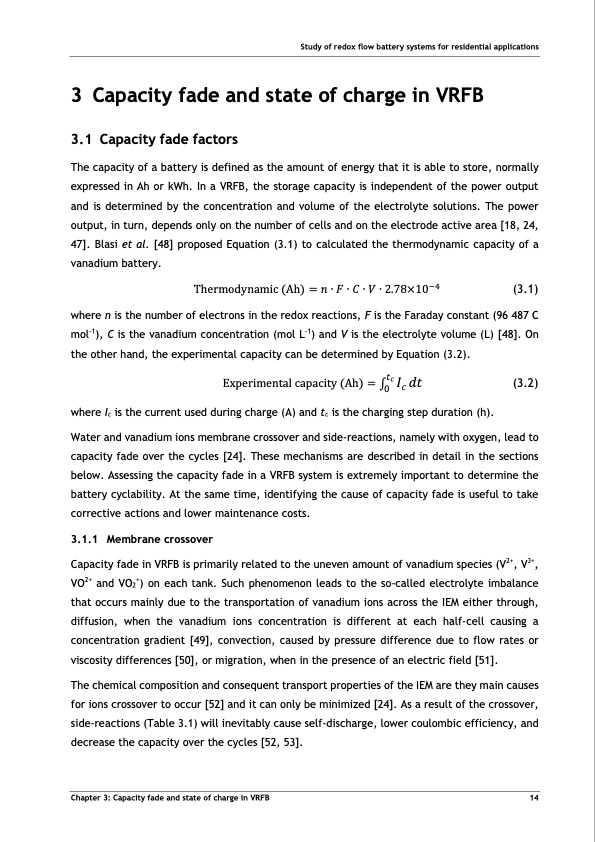
PDF Publication Title:
Text from PDF Page: 025
Study of redox flow battery systems for residential applications 3 Capacity fade and state of charge in VRFB 3.1 Capacity fade factors The capacity of a battery is defined as the amount of energy that it is able to store, normally expressed in Ah or kWh. In a VRFB, the storage capacity is independent of the power output and is determined by the concentration and volume of the electrolyte solutions. The power output, in turn, depends only on the number of cells and on the electrode active area [18, 24, 47]. Blasi et al. [48] proposed Equation (3.1) to calculated the thermodynamic capacity of a vanadium battery. Thermodynamic (Ah) = 𝑛 ∙ 𝐹 ∙ 𝐶 ∙ 𝑉 ∙ 2.78×10−4 (3.1) where n is the number of electrons in the redox reactions, F is the Faraday constant (96 487 C mol-1), C is the vanadium concentration (mol L-1) and V is the electrolyte volume (L) [48]. On the other hand, the experimental capacity can be determined by Equation (3.2). Experimental capacity (Ah) = ∫𝑡𝑐 𝐼𝑐 𝑑𝑡 (3.2) 0 where Ic is the current used during charge (A) and tc is the charging step duration (h). Water and vanadium ions membrane crossover and side-reactions, namely with oxygen, lead to capacity fade over the cycles [24]. These mechanisms are described in detail in the sections below. Assessing the capacity fade in a VRFB system is extremely important to determine the battery cyclability. At the same time, identifying the cause of capacity fade is useful to take corrective actions and lower maintenance costs. 3.1.1 Membrane crossover Capacity fade in VRFB is primarily related to the uneven amount of vanadium species (V2+, V3+, VO2+ and VO2+) on each tank. Such phenomenon leads to the so-called electrolyte imbalance that occurs mainly due to the transportation of vanadium ions across the IEM either through, diffusion, when the vanadium ions concentration is different at each half-cell causing a concentration gradient [49], convection, caused by pressure difference due to flow rates or viscosity differences [50], or migration, when in the presence of an electric field [51]. The chemical composition and consequent transport properties of the IEM are they main causes for ions crossover to occur [52] and it can only be minimized [24]. As a result of the crossover, side-reactions (Table 3.1) will inevitably cause self-discharge, lower coulombic efficiency, and decrease the capacity over the cycles [52, 53]. Chapter 3: Capacity fade and state of charge in VRFB 14PDF Image | Tubular Vanadium Air Redox‐flow battery

PDF Search Title:
Tubular Vanadium Air Redox‐flow batteryOriginal File Name Searched:
204521.pdfDIY PDF Search: Google It | Yahoo | Bing
Salgenx Redox Flow Battery Technology: Salt water flow battery technology with low cost and great energy density that can be used for power storage and thermal storage. Let us de-risk your production using our license. Our aqueous flow battery is less cost than Tesla Megapack and available faster. Redox flow battery. No membrane needed like with Vanadium, or Bromine. Salgenx flow battery
| CONTACT TEL: 608-238-6001 Email: greg@salgenx.com | RSS | AMP |